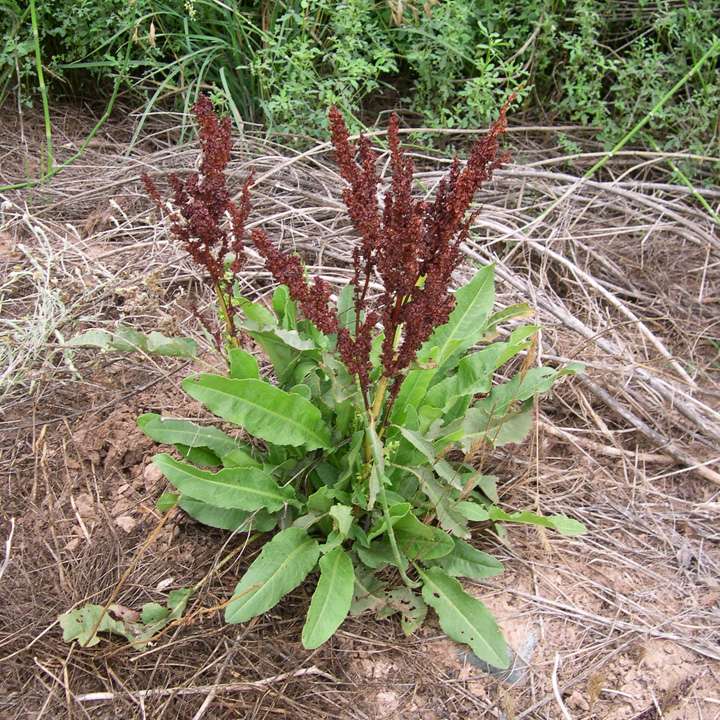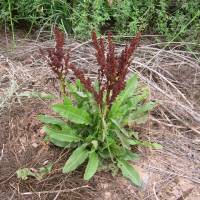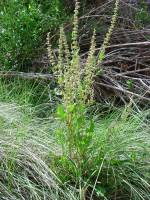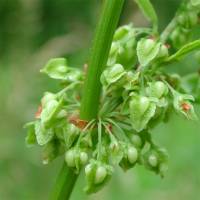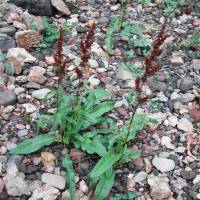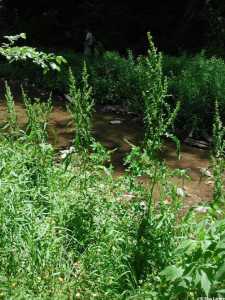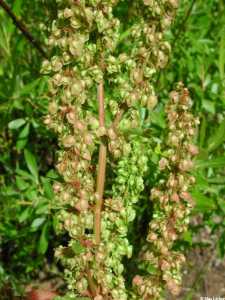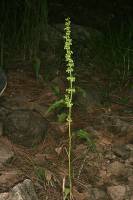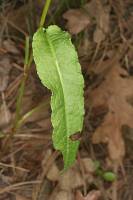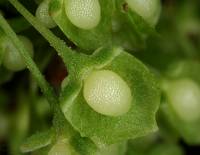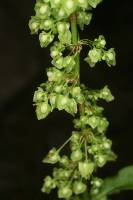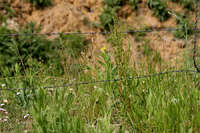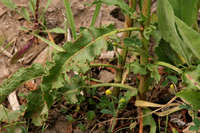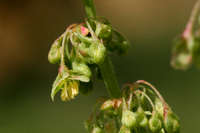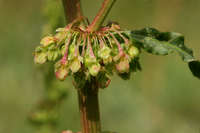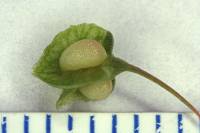Plants perennial, occasionally bi-ennial, glabrous or very indis-tinctly papillose normally only on veins of leaf blades abaxially, with fusiform, vertical rootstock. Stems erect, branched distal to middle, 40-100(-150) cm. Leaves: ocrea deciduous, rarely partially persistent at maturity; blade lanceolate to narrowly lanceolate or lanceolate-linear, normally 15-30(-35) × 2-6 cm, base cuneate, truncate, or weakly cordate, margins entire to subentire, strongly crisped and undulate, apex acute. Inflorescences terminal, occupying distal 2 of stem, dense or interrupted at base, narrowly to broadly paniculate, branches usually straight or arcuate. Pedicels articulated in proximal 3, filiform, (3-)4-8 mm, articulation distinctly swollen. Flowers 10-25 in whorls; inner tepals orbiculate-ovate or ovate-deltoid, 3.5-6 × 3-5 mm, base truncate or subcordate, margins entire or subentire to very weakly erose, flat, apex obtuse or subacute; tubercles normally 3, rarely 1 or 2, unequal, at least 1 distinctly larger, more than (1-)1.5 mm wide. Achenes usually reddish brown, 2-3 × 1.5-2 mm. 2n = 60.
Flowering late spring-early fall. Very broad range of ruderal, segetal, and seminatural habitats, disturbed soil, waste places, cultivated fields, roadsides, meadows, shores of water bodies, edges of woods; 0-2500 m; introduced; St. Pierre and Miquelon; Alta., B.C., Man., N.B., Nfld. and Labr. (Nfld.), N.W.T., N.S., Ont., P.E.I., Que., Sask., Yukon; Ala., Alaska, Ariz., Ark., Calif., Colo., Conn., Del., D.C., Fla., Ga., Idaho, Ill., Ind., Iowa, Kans., Ky., La., Maine, Md., Mass., Mich., Minn., Miss., Mo., Mont., Nebr., Nev., N.H., N.J., N.Mex., N.Y., N.C., N.Dak., Ohio, Okla., Oreg., Pa., R.I., S.C., S.Dak., Tenn., Tex., Utah, Vt., Va., Wash., W.Va., Wis., Wyo.; Eurasia; introduced almost worldwide.
Rumex crispus (belonging to subsect. Crispi Rechinger f.; see K. H. Rechinger 1937) is the most widespread and ecologically successful species of the genus, occuring almost worldwide as a completely naturalized and sometimes invasive alien. It has not been reported from Greenland, but it probably occurs there.
Rumex crispus hybridizes with many other species of subg. Rumex. Hybrids with R. obtusifolius (Rumex ×pratensis Mertens & Koch) are the most common in the genus, at least in Europe, and have been reported for several localities in North America. Rumex crispus × R. patientia (Rumex ×confusus Simonkai) was reported from New York. According to R. S. Mitchell (1986, p. 47), 'this hybrid is now spreading along highway shoulders, and it has replaced R. crispus in some local areas.' However, that information should be confirmed by more detailed studies since spontaneous hybrids between species of sect. Rumex usually are much less fertile and ecologically successful than the parental species. Hybrids of Rumex occuring in North America need careful revision.
Numerous infraspecific taxa and even segregate species have been described in the Rumex crispus aggregate. Many seem to represent minor variation of little or no taxonomic significance, but some are geographically delimited entities that may deserve recognition as subspecies or varieties. The typical variety has inner tepals with three well-developed tubercles; the less common var. unicallosus Petermann, with one tubercle, occurs sporadically in North America.
Some eastern Asian plants differ from typical Rumex crispus is having somewhat smaller inner tepals, longer pedicels, lax inflorescences with remote whorls, and narrower leaves that are almost flat or indistinctly undulate at the margins. These plants, originally described as R. fauriei Rechinger f., are now treated as R. crispus subsp. fauriei (Rechinger f.) Mosyakin & W. L. Wagner; the subspecies was recently reported from Hawaii (S. L. Mosyakin and W. L. Wagner 1998) and may be expected as introduced in western North America.
A common weed in low ground in cultivated fields, along streams, and in woodland on the border of swamps, ponds, and sloughs. It is one of our most obnoxious weeds. The root was formerly official in medicine and was sold usually under the name of yellow dock. Formerly the early spring leaves were mixed with those of the dandelion and cooked for food. The mixture was called "greens." The discovery, however, that the leaves contain calcium oxalate, which is injurious, has decreased the popularity of this practice. The farmers in Indiana usually call this plant sour dock. The tubercles of the valves of the same plant may vary at the apex from obtuse to acute. Rumex elongatus Guss. is a form of this species with acute tubercles but since both acute and obtuse forms can be found on the same plant, all reports for this species should be referred to Rumex crispus.
Duration: Perennial
Nativity: Non-Native
Lifeform: Forb/Herb
General: Perennial herb, 30-120 cm tall, from a spindle-shaped, vertical rootstock; stems stout, erect, simple or branched above the middle, glabrous, and greenish to reddish.
Leaves: In a basal rosette and alternate along the stems, on slender petioles. Basal leaves lanceolate, 10-40 cm long, with ruffled (crisped) edges; stem leaves smaller. Ocrea (stipules fused into a sheath which surrounds the stem at the base of each leaf) 1-7 cm long, tan, membranaceous, early-deciduous.
Flowers: Greenish, in a terminal panicle which occupies the top half of the plant; panicle branches ascending, 10-50 cm long and densely flowered with whorls of 10- 25 bisexual flowers; each flower has 3 outer bract-like tepals and 3 winged inner tepals called valves which enlarge to 4-6 mm long in fruit, the wings forming a broadly ovate to orbicular shape with mostly entire margins; each valve usually has a grain-like tubercle called a callosity.
Fruits: Achenes trigonous, 2-3 mm high, reddish-brown, surrounded by the three enlarged inner tepals (valves).
Ecology: Found in moist areas from 3,000-9,000 ft (914-2743 m); ubiquitous in temperate North America; flowers March-October.
Distribution: Native to Eurasia and northern Africa; naturalized throughout the world; throughout N. Amer. and in every state in the US.
Notes: An incredibly common tall biennial or perennial of moist soils; distinguished by the leaves which are crinkled or crisped along the edges, hence the species' name; the inner tepals or valves, seen as 3 wings on the fruits, are 4-6 mm long, have edges that are mostly without teeth, and have drops of hard tissue in the middle termed collosities. The inflorescence, which encompasses the top half of the plant, is distinctly red when in fruit. Host plant for Purplish Copper butterfly.
Ethnobotany: Plant is used by many tribes medicinally. Common uses are root or seed poultices for swelling and skin irritations. Considered a liver stimulant and blood purifier. Some tribes make tea to purify blood or treat urinary problems. Tea salve is made for skin problems. Slow root tea is used to treat diarrhea, stimulate appetite, and for intestinal cold. Tea is also made into a wash for face, hands and clothing as love medicine. Seeds, greens and stems are consumed by many tribes. Pima, Cheyenne, and Choctaw also make yellow dye from roots.
Etymology: Rumex is the classical Latin name for dock, possibly derived from rumo, to suck, in reference to the practice of sucking the leaves to allay thirst; crispus is from the Latin crisp, meaning curled, in reference to the leaves.
Synonyms: None
Editor: SBuckley 2010, FSCoburn 2015, AHazelton 2015, AHazelton 2017
Stout, taprooted perennial to 1.5 m, simple to the infl; lvs strongly crisped, the larger commonly rounded to subcordate at the base; infl large, with many ascending or erect branches, becoming compact at maturity, with some linear lvs intermingled; pedicels flexuous, 5-10 mm, spreading-decurved, jointed near the base; valves thin, broadly ovate, 4-5 mm long and wide, entire or nearly so, obtuse, truncate or subcordate at base; grains 3, often unequal, the larger broadly ovoid, very turgid, rounded at both ends, half as long as the valve; 2n=60. Native of Europe, found as a weed of roadsides, fields, and waste ground throughout the U.S. and s. Can. (R. elongatus) Hybridizes with nos. 9 [Rumex patientia L.] and 16 [Rumex obtusifolius L.].
Gleason, Henry A. & Cronquist, Arthur J. 1991. Manual of vascular plants of northeastern United States and adjacent Canada. lxxv + 910 pp.
©The New York Botanical Garden. All rights reserved. Used by permission.
Rumex crispus subsp. crispus is a tall perennial most easily recognized by the acute, lanceolate leaves which are narrow (at least compared to Rumex hymenosepalus) and very "crisped" or wavy along the edges. Rumex crispus is found along streambeds and in moist areas in canyons.


